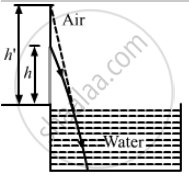Advertisements
Advertisements
Question
Suppose you are inside the water in a swimming pool near an edge. A friends is standing on the edge. Do you find your friend taller or shorter than his usual height?
Solution
When viewed from the water, the friend will seem taller than his usual height.
Let actual height be h and the apparent height be h'.
Here, the refraction is taking place from rarer to denser medium and a virtual image is formed.
Using
\[\frac{\mu_1}{- u} + \frac{\mu_2}{v} = \frac{\mu_2 - \mu_1}{R}\]
Where refractive index of water is μ2 and refractive index of air is μ1.
u and v are object and image distances, respectively.
R is the radius of curvature, here we will take it as ∞.
\[\frac{\mu_1}{- u} + \frac{\mu_2}{v} = \frac{\mu_2 - \mu_1}{\infty}\]
\[\frac{\mu_1}{u} = \frac{\mu_2}{v}\]
\[v = \frac{\mu_2}{\mu_1} \times u\]
We know magnification is given by:
\[m = \frac{v}{u}\]
Putting the value of v in the above equation:
\[m = \frac{u \times \mu_2}{u}\]
\[m = \mu_2 \]
As the magnification is greater than 1, so the apparent height seems to be greater than actual height.
APPEARS IN
RELATED QUESTIONS
Give a scientific reason:
Danger signals are red in colour.
Why can’t we see clearly through fog?
Name the phenomenon responsible for it.
Show with the help of a diagram, how unpolarised light from Sun gets linearly polarised by scattering.
Draw the intensity distribution for the fringes produced in interference ?
Write two points of difference between the phenomena of interference and diffraction.
What is linearly polarized light?
A concave mirror forms an image of 20 cm high object on a screen placed 5.0 m away from the mirror. The height of the image is 50 cm. Find the focal length of the mirror and the distance between the mirror and the object.
k transparent slabs are arranged one over another. The refractive indices of the slabs are μ1, μ2, μ3, ... μk and the thicknesses are t1 t2, t3, ... tk. An object is seen through this combination with nearly perpendicular light. Find the equivalent refractive index of the system which will allow the image to be formed at the same place.
An optical fibre (μ = 1.72) is surrounded by a glass coating (μ = 1.50). Find the critical angle for total internal reflection at the fibre-glass interface.
Light falls from glass (μ = 1.5) to air. Find the angle of incidence for which the angle of deviation is 90°.
A point source is placed at a depth h below the surface of water (refractive index = μ). (a) Show that light escapes through a circular area on the water surface with its centre directly above the point source. (b) Find the angle subtended by a radius of the area on the source.
A container contains water up to a height of 20 cm and there is a point source at the centre of the bottom of the container. A rubber ring of radius r floats centrally on the water. The ceiling of the room is 2.0 m above the water surface. (a) Find the radius of the shadow of the ring formed on the ceiling if r = 15 cm. (b) Find the maximum value of r for which the shadow of the ring is formed on the ceiling. Refractive index of water = 4/3.
A paperweight in the form of a hemisphere of radius 3.0 cm is used to hold down a printed page. An observer looks at the page vertically through the paperweight. At what height above the page will the printed letters near the centre appear to the observer?
The diameter of the sun is 1.4 × 109 m and its distance from the earth is 1.5 × 1011 m. Find the radius of the image of the sun formed by a lens of focal length 20 cm.
Answer the following question in detail.
Is it possible to see primary and secondary rainbow simultaneously? Under what conditions?
A plano-convex lens is made of material having refractive index 1.5. The radius of curvature of curved surface is 40 cm. The focal length of the lens is ____________ cm.
Explain the formation of primary and secondary rainbow.
A parallel beam of light of wavelength 5890 Å falls normally on a slit of width 0.2 mm. Find the distance between the first minima on the two sides of the central maximum of the diffraction pattern observed on a screen placed in the focal plane of a convex lens of focal length 50 cm. The lens is placed quite close to the slit.
